
Tiziano Vecellio, Latinized as Titianus, hence known in English as Titian, was an Italian Renaissance painter, the most important artist of Renaissance Venetian painting. He was born in Pieve di Cadore, near Belluno. During his lifetime he was often called da Cadore, 'from Cadore', taken from his native region.

Alessandro Bonvicino, more commonly known as Moretto, or in Italian Il Moretto da Brescia, was an Italian Renaissance painter from Brescia, where he also mostly worked. His dated works span the period from 1524 to 1554, but he was already described as a master in 1516. He was mainly a painter of altarpieces that tend towards sedateness, mostly for churches in and around Brescia, but also in Bergamo, Milan, Verona, and Asola; many remain in the churches they were painted for. The majority of these are on canvas, but a considerable number, including some large pieces, are created on wood panels. There are only a few surviving drawings from the artist.
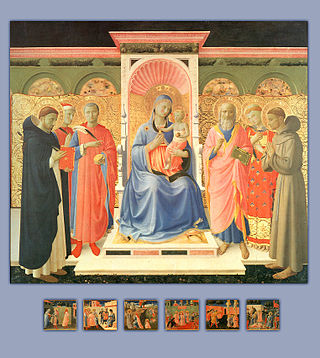
In art, a sacra conversazione, meaning "holy conversation", is a genre developed in Italian Renaissance painting, with a depiction of the Virgin and Child amidst a group of saints in a relatively informal grouping, as opposed to the more rigid and hierarchical compositions of earlier periods. Donor portraits may also be included, generally kneeling, often their patron saint is presenting them to the Virgin, and angels are frequently in attendance.

The Annunciation is a painting by the Italian Renaissance master Titian, executed between 1559 and 1564. It remains in the church of San Salvador in Venice, for which it was commissioned.
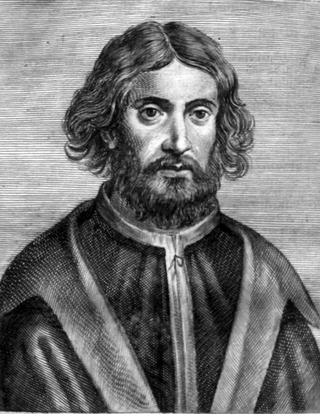
Palma Vecchio, born Jacopo Palma, also known as Jacopo Negretti, was a Venetian painter of the Italian High Renaissance. He is called Palma Vecchio in English and Palma il Vecchio in Italian to distinguish him from Palma il Giovane, his great-nephew, who was also a painter.

The Crucifixion is a life sized painting by the Venetian artist Titian, completed in 1558 and presently hanging in the sanctuary of the church of San Domenico, Ancona. Jesus Christ is shown crucified, with Saint Mary and Saint John standing either side of the cross in the Stabat Mater tradition. The kneeling figure is of Saint Dominic. The canvas was completed during Titian's fifth decade of painting, and is one of the works marking a shift toward his extensive exploration of tragedy and human suffering.
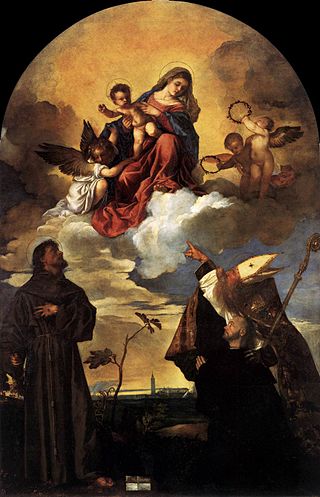
The Gozzi Altarpiece is an oil painting by the Italian Renaissance master Titian, dating from 1520. It is located in the Pinacoteca civica Francesco Podesti, in Ancona.
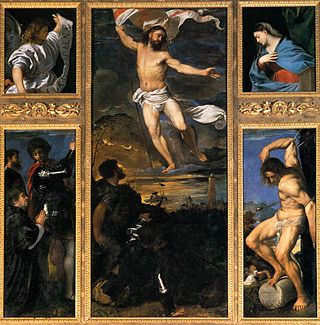
The Averoldi Polyptych, also known as the Averoldi Altarpiece, is a painting by the Italian Renaissance painter Titian, dating to 1520–1522, in the basilica church of Santi Nazaro e Celso in Brescia, northern Italy.
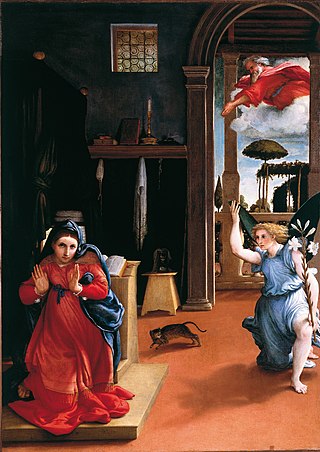
The Recanati Annunciation is an oil-on-canvas painting by the Italian Renaissance painter Lorenzo Lotto, executed around 1534 and housed in the Civic Museum of Villa Colloredo Mels, Recanati, Italy.
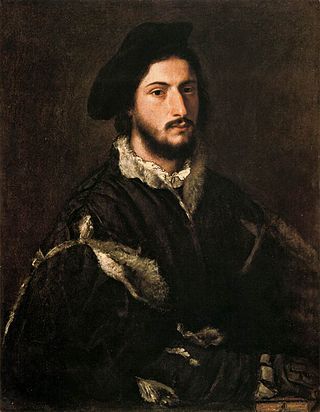
Portrait of Vincenzo Mosti is a painting by Titian, executed around 1520. It is housed in the Galleria Palatina, in Florence.
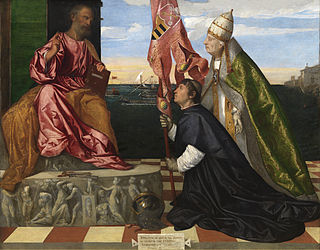
Jacopo Pesaro being presented by Pope Alexander VI to Saint Peter is an oil painting on canvas by Titian, now in the Royal Museum of Fine Arts in Antwerp.
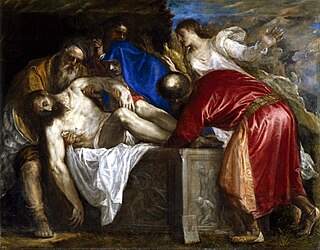
The Entombment is a 1559 oil-on-canvas painting by the Venetian painter Titian, commissioned by Philip II of Spain. It depicts the burial of Jesus in a stone sarcophagus, which is decorated with depictions of Cain and Abel and the binding of Isaac. The painting measures 137 cm × 175 cm and is now in the Museo del Prado in Madrid. Titian made several other paintings depicting the same subject, including a similar version of 1572 given as a gift to Antonio Pérez and now also in the Prado, and an earlier version of c.1520 made for the Duke of Mantua and now in the Louvre.

The Entombment of Christ is a c. 1520 painting by Titian, now in the Musée du Louvre, in Paris.

The Bacchanal of the Andrians or The Andrians is an oil painting by Titian. It is signed "TICIANUS F.[aciebat]" and is dated to 1523–1526.
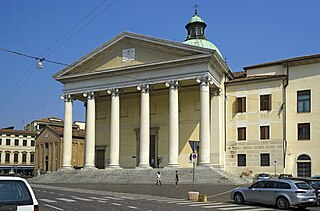
Treviso Cathedral is a Roman Catholic cathedral in Treviso, Veneto, northern Italy, dedicated to Saint Peter. It is the seat of the bishop of Treviso.

Saint Titian of Oderzo was a 7th-century bishop of Opitergium (Oderzo), in the Province of Treviso.
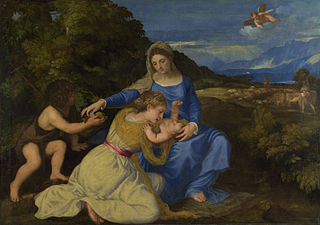
The Aldobrandini Madonna is an oil painting on canvas by Titian, dating to c. 1530. It is held in the National Gallery, in London. There are studio copies in the Galleria Palatina, in Florence, and in the Kunsthistorisches Museum, in Vienna.

Holy Family with a Shepherd is an oil on canvas painting by Titian, from c. 1510. It is held in the National Gallery, in London. It has also previously been attributed to Anthony van Dyck, who produced a drawing copying it. After passing through other private collections, it was bequeathed to the National Gallery by William Holwell Carr in 1831.

Madonna and Child with Four Saints or Madonna and Child with Saints John the Baptist, Paul, Mary Magdalene and Jerome is a c. 1516-1520 oil on panel painting by Titian, now in the Gemäldegalerie in Dresden. It belongs to the sacra conversazione genre and features saints John the Baptist, Paul, Mary Magdalene and Jerome.

The Virgin and Child with Saint John the Baptist and an Unidentified Saint, also called the Virgin with Saint John the Baptist, Adored by a Donor, is a religious painting by Titian, dated to c. 1515-1520. It is currently on loan to the Scottish National Gallery, in Edinburgh.




















